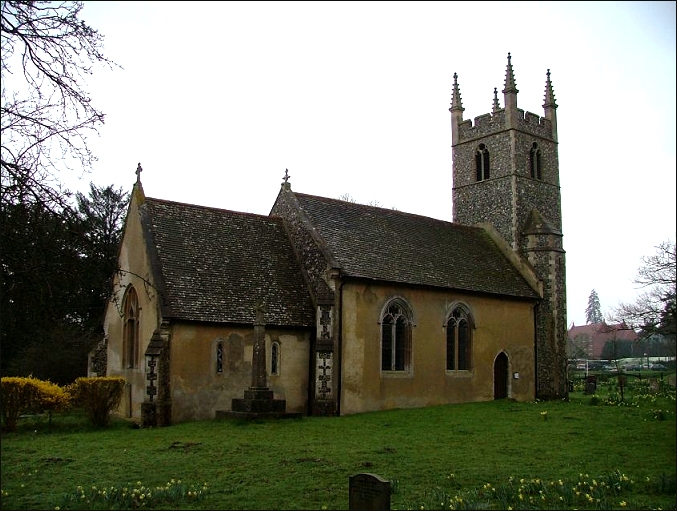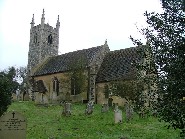| |
|
St
Remigius, Dunston
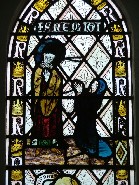 |
|
The
massive Victorian pile of Dunston Hall will be
familiar to anyone who has travelled along the
main road between Norwich and Ipswich. For years
it was derelict, a brooding presence shadowed by
unmanaged woodland, but today it is a busy hotel
and conference centre, fringed by that
increasingly found blot on the rural landscape, a
golf course. There are still a few trees, of
course, and among them sits St Remigius. It is often
the case with churches in this area just to the
south of Norwich that they appear deceptively
remote, and that is certainly the case here. You
cannot reach the church through the massive gate
on the main road which leads to the hotel
grounds, which are, in any case, private.
Instead, you have to walk several hundred metres
from the back road to Stoke Holy Cross. When you
get there, the graveyard is like a little oasis,
this pretty little church in the middle. Access,
as with a number of churches around here, is
through the north door, and the stone path
outside it is slippery in wet weather, so do be
careful.
|
As I say,
the church is pretty, but doesn't really promise much
from the outside. The chancel is interesting, with its
Norman lancets, but there was a pretty overwhelming
restoration, and money does not seem to have been in
short supply here in the late 19th century. This may lead
you to think it isn't worth getting the key, which is way
off near Stoke Holy Cross, but there is much more to
Dunston than meets the eye.
From the
photograph at the top of this page, it may not be
immediately clear quite how small the building is. The
crispness of what was essentially a Victorian rebuilding
of the tower, and replacement of all the window tracery,
makes a little wedding cake of it. It was clearly
intended to be a 'view' from the Hall. But the church you
step into is by no means the urban, anonymous restoration
that you might fear or expect. Here is a delightful,
rural space, a Victorianisation on a small scale, which
has retained many good things and furnished others.
The most
spectacular survival is the 15th century rood screen,
only two bays each side of the central walkway, but
imposing in this small building. The panels have been
lost, but the lights of the upper tracery and the
spandrils are a riot of bubbly carving. Best of all are
the figures above the centre section. A wolf is paired
with a lion fighting a dragon. Above, a more imposing,
almost oriental dragon, watches as a determined wild man
creeps up on the opposite side. Wonderful stuff.
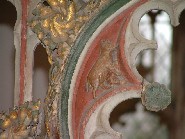 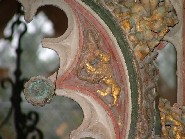 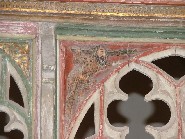 
Walking
through into the tiny chancel is like stepping into a
jewel. The east window tracery is made of carved and
polished alabaster, as if this was the side chapel of a
Cathedral or great city church rather than an East
Anglian backwater. It dates from a cosiderable reordering
in the early years of the 20th century, as does the glass
on the south side, which is all good, and some of it is
medieval. This includes part of the figure of a beautiful
St Christopher carrying the Christchild through a fishy
lake, and a woman donor kneeling before St Remigius.
Possibly these were bought from elsewhere for the
restoration; the modern parts are by the King workshop of
Norwich, I think. An unlikely find is another composite
representing St Nicomedes, who I don't think I have come
across elsewhere in East Anglia.
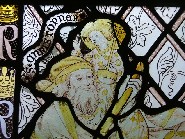
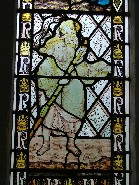  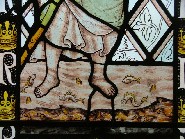
What at first appears to be another medieval
survival is the excellent set of three figure brasses in
the sanctuary. In fact, they are later, perhaps 1630s,
and depict Clere Talbot between his two wives (not at the
same time, of course). The wives lie in their shrouds,
looking like nothing so much as if they have been
interrupted in the bath. The inscription is to the
second, Ann, and her figure brass is the best of the
three.
| A
puzzle is the pair of little openings either side
within the tower arch. Can they be, as Mortlock
suggests, partially filled in banner stave
lockers? He also draws our attention to the
elegant and oratorial ledger stone to Susan Long
in the chancel. There are other memorials from
the 18th and 19th centuries to various members of
the Long family, but walking back down the
church, you sense again that the busy life of
this place was lived in the early decades of the
20th century. Perhaps, like so many of the landed
estates of East Anglia, it was the First World
War that brought all the prosperity to an end. As the
historian AJP Taylor has observed, the Victorian
era lingered on in rural England and finally came
to a close on the Fourth of August 1914, when war
was declared. Nothing would ever be the same
again.The alabaster tracery and a hanging Art
Nouveau lamp speaks of the confidence and
elegance of the years before. The original WWI
Roll of Honour survives in a frame to remind us
of what was lost.
|
|
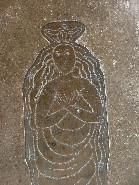 |
|
|
|

